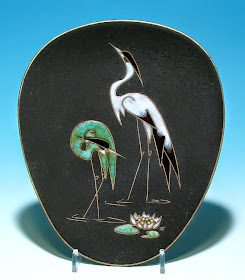Designer Otto Gerharz developed the Vulkano glaze in 1951, which was a forerunner of the thick, dripping fat lava glaze that later characterized much of West German pottery. Other notable designers were Hanns Welling and Adele Bölz.
Rucha pottery is made of white clay and often has an especially neat unglazed ring on the bottom. Markings vary from early handwritten ones, to embossed ones that include the usual for and height in centimeters or just a single number. Some later pieces have the company name embossed on the bottom. Foil stickers were also used.
For many years, Otto Keramik has been producing bull figurines from the original Ruscha molds, and since neither the original Ruscha pieces nor the newer Otto pieces are marked, they can only be distinguished by glazes.
From ginforsodditiques and potsandpots.com
 |
| flickr.com - after glow retro |
 |
| vintage-design-cologne.blogspot.com |
 |
| etsy.com - TheLavaLounge |
 |
| etsy.com - vintageberlin36 |
 |
| etsy.com - RetroFatLava |
 |
| etsy.com - 1001vintage |
 |
| etsy.com - GermanZeitgeist |
 |
| ebay.com - taeglichamstrand |







Love the pieces in the first 2 photos especially Dana
ReplyDeleteThose pieces, especially the one in the first photo, are unusually beautiful to me too.
DeleteYou know I love the 313 pitcher, but there isn't a single one of these pieces I wouldn't adore having in my home!
ReplyDeleteThe shape of that pitcher is stunning, isn't it? It will never go out of style.
Delete